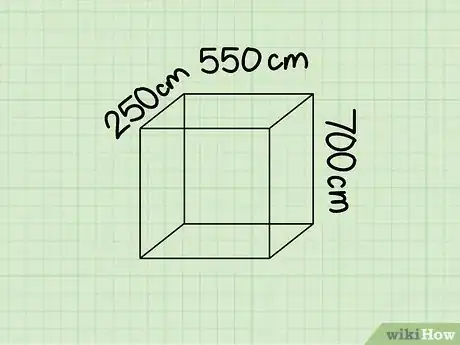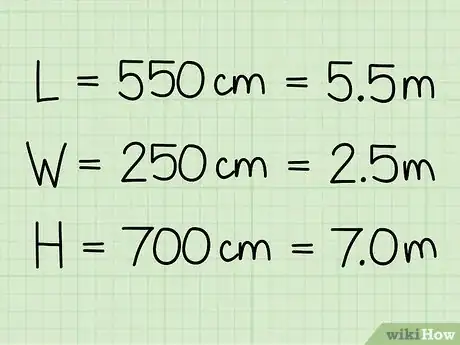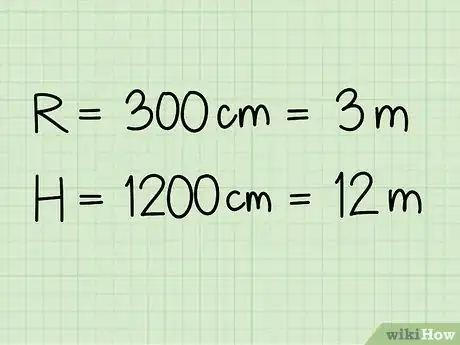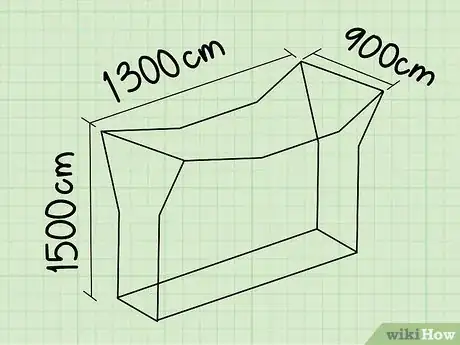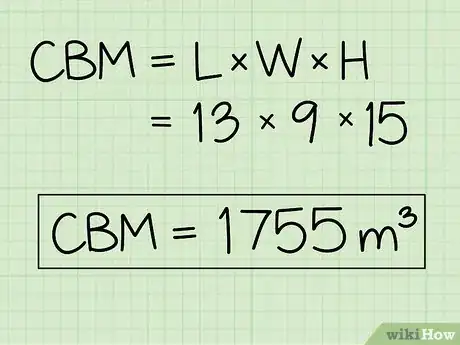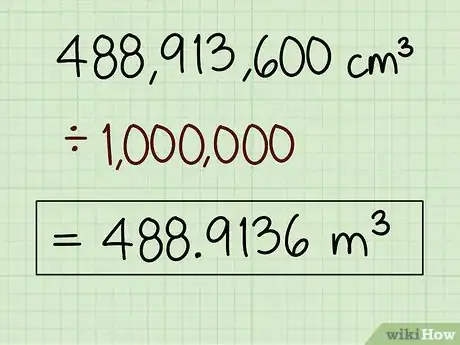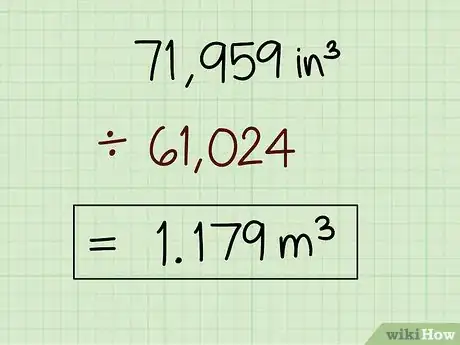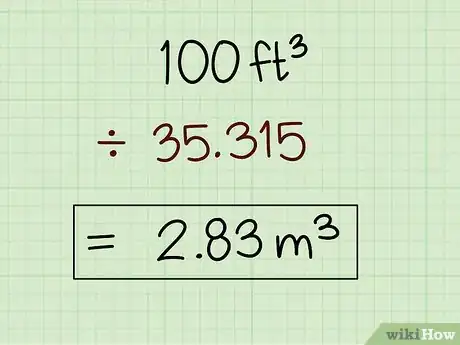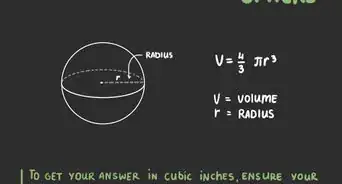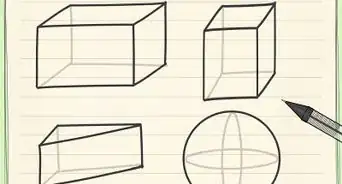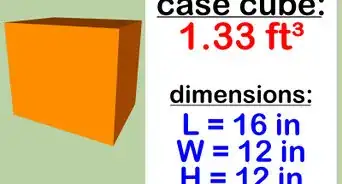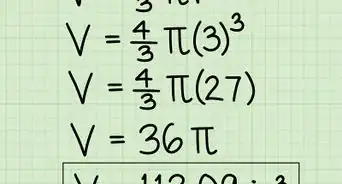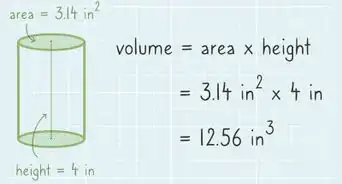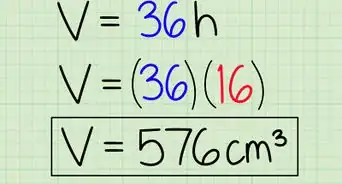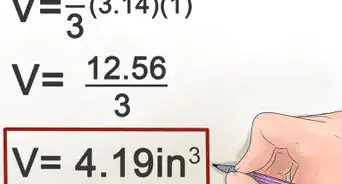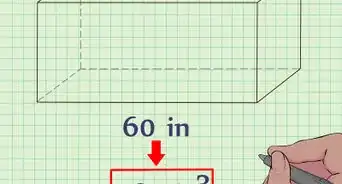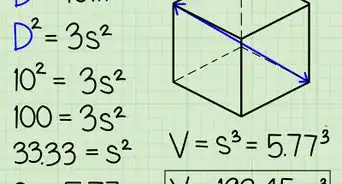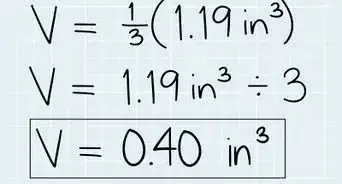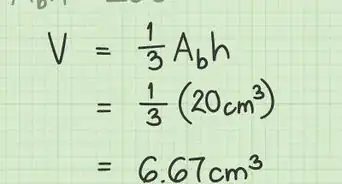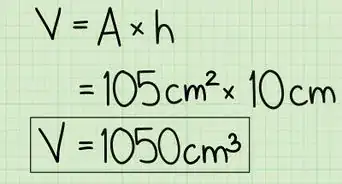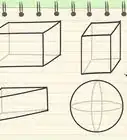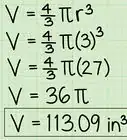This article was co-authored by wikiHow staff writer, Sophia Latorre. Sophia Latorre is a Content Manager on the wikiHow team. Before joining wikiHow, Sophia worked as a technical editor and was published in six International Energy Agency (IEA) Wind Annual Reports. Now, she writes, edits, and reviews articles for the wikiHow Content Team, working to make the content as helpful as possible for readers worldwide. Sophia holds a BA in English from Colorado State University.
There are 12 references cited in this article, which can be found at the bottom of the page.
wikiHow marks an article as reader-approved once it receives enough positive feedback. In this case, 87% of readers who voted found the article helpful, earning it our reader-approved status.
This article has been viewed 370,174 times.
Learn more...
“CBM” stands for “cubic meters” and these units are typically used when referring to the volume of freight packages. In other words, CBM tells you how much space a package occupies. Though it might sound confusing, calculating CBM is actually super simple. Measure the carton, convert the units to meters if necessary, then use the volume formula that corresponds with the shape of your carton to determine the CBM. Additionally, if you know the volume of your package in cubic centimeters, inches, or feet, you can convert those units to cubic meters in a few simple steps.
Steps
Calculating CBM for a Rectangular Prism
-
1Measure the sides of the carton. Use a measuring tape to find the length, width, and height of the rectangular carton. Write down each measurement so you can refer back to them.[1]
-
2Convert the measurements into meters, if necessary. For small packages, you may end up taking measurements in centimeters, inches, or feet. Before you can calculate CBM, convert each measurement into its equivalent value in meters.
- To convert centimeters to meters, divide by 100. For example, if the length is 15 centimeters, divide 15 by 100, which is equal to 0.15 meters.[2]
- To convert inches to meters, divide by 39.37. For instance, if the width is 10 inches, divide 10 by 39.37, which is equal to 0.254 meters.[3]
- To convert feet to meters, multiply by 0.305. For example, if the height is 5 feet, multiply 5 by 0.305, which is equal to 1.525 meters.[4]
Advertisement -
3Multiply the length, width, and height of the carton. To find the CBM, use the standard formula for volume and multiply the length, width, and height of the rectangular prism.[5]
- For example, say the length is 5.5 meters, the width is 2.5 meters, and the height is 7.0 meters: 5.5 x 2.5 x 7.0 = 96.25, so the CBM is 96.25 cubic meters.
Tip: The formula for the volume of a rectangular prism is: V = L x W x H where V = volume, L = length, W = width, and H = height.
Determining CBM for a Cylinder
-
1Measure the height and radius of the carton. When dealing with tubes and other cylindrical packages, you'll need to know the height of the cylinder as well as the radius of its circular sides. Find these measurements using a measuring tape, then write both down separately.[6]
Tip: Note that the radius of the circular side is half its diameter and the diameter is the distance from one side of the circular face to the other. To find the radius, measure the diameter of one circular face and split the number in half.
-
2Convert the measurements into meters, if necessary. If you took your measurements in centimeters, inches, or feet, it will be easiest to convert these units to meters before you calculate CBM.
- To convert centimeters to meters, divide by 100. For instance, if the height is 90 centimeters, divide 90 by 100, which is equal to 0.90 meters.[7]
- To convert inches to meters, divide by 39.37. For example, if the radius is 75 inches, divide 75 by 39.37, which is equal to 1.905 meters.[8]
- To convert feet to meters, multiply by 0.305. For instance, if the height is 20 feet, multiply 20 by 0.305, which is equal to 6.1 meters.[9]
-
3Use the formula V = πr2h to find the CBM. In this equation, V = volume, π = 3.14, r = radius, and h = height. Simply plug the measurements you found for the radius and height of the cylinder into the equation and solve it.[10]
- For instance, say the radius of your package is 3 meters and the height is 12 meters. Start by squaring the radius: 32 = 9. Multiply 3.14 by 9 by 12, which is equal to 339.12, so the volume of the cylinder is 339.12 cubic meters.
Finding CBM for an Irregular Carton
-
1Measure the greatest distances. Treat an irregularly shaped package like a rectangular package when calculating CBM, but since there is no consistent length, width, and height, you must identify the longest, widest, and tallest portions of the package and measure those maximum distances with a measuring tape. Write down each measurement.[11]
- Even though CBM is a measurement of volume, there is no standard formula to use when calculating the volume of an irregularly shaped three-dimensional object. Instead of finding an exact volume, you can only calculate an estimated one.
-
2Convert the measurements into meters, if necessary. If you took the length, height, and width in centimeters, inches, or feet, convert those measurements into meters before calculating the package's cubic meters.
- To convert centimeters to meters, divide by 100. For example, if the length is 605 centimeters, divide 605 by 100, which is equal to 6.05 meters.[12]
- To convert inches to meters, divide by 39.37. For instance, if the width is 98 inches, divide 98 by 39.37, which is equal to 2.489 meters.[13]
- To convert feet to meters, multiply by 0.305. For example, if the height is 17 feet, multiply 17 by 0.305, which is equal to 5.185 meters.[14]
-
3Multiply the length, width, and height to find the CBM. Treat the package as though it were a rectangular unit and multiply the maximum length, width, and height of the unit. This is the formula to determine the volume of any rectangular prism.[15]
- For instance, if the length is 13 meters, the width is 9 meters, and the height is 15 meters, multiply 13 by 9 by 15, which is 1,755. So, the volume of the unit is 1,755 cubic meters.
Tip: To find the total CBM for an entire shipment, simply add the CBM for each carton together.
Converting Other Units to Cubic Meters
-
1Divide by 1 million to convert cubic centimeters to cubic meters. There are 1,000,000 cubic centimeters in 1 cubic meter. That means you must divide the number of cubic centimeters by 1,000,000 to convert to cubic meters.[16]
- For example, say your carton has a volume of 488,913,600 cubic centimeters. Divide 488,913,600 by 1,000,000. The carton’s volume is equal to 488.9136 cubic meters.
-
2Divide by 61,024 to convert cubic inches to cubic meters. Inches are an imperial unit while meters are a metric unit. Even still, it’s easy to convert between the two. Take the volume measurement in cubic inches and divide it by 61,024 to convert to cubic meters.[17]
- For instance, if your package is 71,959 cubic inches, divide 71,959 by 61,024, which is equal to 1.179 cubic meters.
-
3Divide by 35.315 to convert cubic feet to cubic meters. If you know the volume of the carton in cubic feet, you can easily convert the units to cubic meters. Just divide the number of cubic feet by 35.315 to find the number of cubic meters.[18]
- For example, if your carton is 100 cubic feet, divide 100 by 35.315, which is equal to 2.83 cubic meters.
Community Q&A
-
QuestionHow do I calculate CBM in inches?
 DonaganTop AnswererMultiply the number of cubic meters by 61,023.377 to get the volume in cubic inches.
DonaganTop AnswererMultiply the number of cubic meters by 61,023.377 to get the volume in cubic inches. -
QuestionWhy is pi used when calculating the CBM of a cylindrical unit?
 DonaganTop AnswererPi is used to calculate the area of a circle, which is used in calculating the volume of a cylinder.
DonaganTop AnswererPi is used to calculate the area of a circle, which is used in calculating the volume of a cylinder. -
QuestionHow would I go about calculating irregular packaging?
 DonaganTop AnswererDo it as explained in Method 3 above.
DonaganTop AnswererDo it as explained in Method 3 above.
References
- ↑ https://sciencing.com/calculate-cubic-meters-4759883.html
- ↑ https://sciencing.com/convert-centimeters-meters-5329285.html
- ↑ https://www.metric-conversions.org/length/inches-to-meters.htm
- ↑ https://sciencing.com/calculate-height-feet-meters-7804854.html
- ↑ https://sciencing.com/calculate-specific-gravity-density-7768709.html
- ↑ https://www.omnicalculator.com/math/cylinder-volume
- ↑ https://sciencing.com/convert-centimeters-meters-5329285.html
- ↑ https://www.metric-conversions.org/length/inches-to-meters.htm
- ↑ https://sciencing.com/calculate-height-feet-meters-7804854.html
- ↑ https://www.mathopenref.com/cylindervolume.html
- ↑ https://www.omnicalculator.com/other/cbm-shipping#how-to-calculate-cbm-when-your-package-is-irregularly-shaped
- ↑ https://sciencing.com/convert-centimeters-meters-5329285.html
- ↑ https://www.metric-conversions.org/length/inches-to-meters.htm
- ↑ https://sciencing.com/calculate-height-feet-meters-7804854.html
- ↑ https://www.omnicalculator.com/math/volume
- ↑ https://www.metric-conversions.org/volume/cubic-centimeters-to-cubic-meters.htm
- ↑ https://www.metric-conversions.org/volume/cubic-inches-to-cubic-meters.htm
- ↑ https://www.metric-conversions.org/volume/cubic-feet-to-cubic-meters.htm
About This Article
To calculate cubic meters for a rectangular item, start by measuring its length, width, and height in meters together. Then, multiply all 3 measurements to get the total amount. If you’re calculating for a cylindrical prism, measure the height and radius of the object in meters. Then, multiply height × r^2 × π, where r is the radius. However, if you’re calculating for an irregular unit, multiply the greatest length, width, and height to get the total amount. For more information on calculating cubic meters, like measuring a total shipment, read on!
